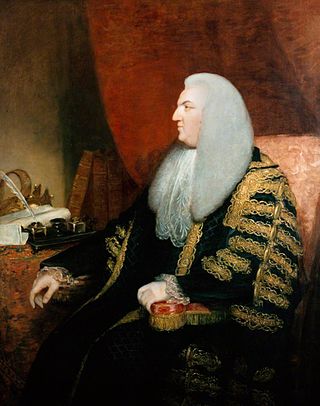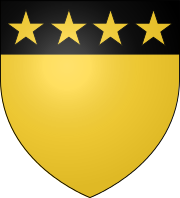
Earl of Home is a title in the Peerage of Scotland. It was created in 1605 for Alexander Home of that Ilk, 6th Lord Home. The Earl of Home holds, among others, the subsidiary titles of Lord Home and Lord Dunglass (1605) in the Peerage of Scotland, and Baron Douglas, of Douglas in the County of Lanark (1875), in the Peerage of the United Kingdom. Various Earls of Home have also claimed the title of Lord Hume of Berwick. The Earl is also Chief of the Name and Arms of Home and heir general to the House of Douglas. The title of Lord Dunglass is used as a courtesy title by the eldest son of the Earl.

Earl of Onslow, of Onslow in the County of Shropshire and of Clandon Park in the County of Surrey is a title in the Peerage of the United Kingdom. It was created in 1801 for George Onslow, 4th Baron Onslow.

Earl Jellicoe is a title in the Peerage of the United Kingdom. It was created, along with the subsidiary title Viscount Brocas, of Southampton in the County of Southampton, on 29 June 1925 for Admiral of the Fleet John Jellicoe, 1st Viscount Jellicoe, on his return from being Governor-General of New Zealand, with remainder to the heirs male of his body. He had already been created Viscount Jellicoe, of Scapa in the County of Orkney, on 15 January 1918, created with remainder to the heirs male of his body, and in default of such issue to his eldest daughter and the heirs male of her body, with the like remainder in default of such issue to every other daughter successively in order of priority of birth, and to the heirs male of their bodies. The Jellicoe viscountcy was created with remainder to his daughters and their heirs male because, at the time of the creation, Jellicoe had five daughters and no sons. His only son was born three months later.

Earl of Kimberley, of Kimberley in the County of Norfolk, is a title in the Peerage of the United Kingdom. It was created in 1866 for the prominent Liberal politician John Wodehouse, 3rd Baron Wodehouse. During his long political career, he notably held office as Lord Lieutenant of Ireland, Secretary of State for the Colonies, Secretary of State for India and Secretary of State for Foreign Affairs. He was succeeded by his son, the second Earl. At first a Liberal like his father, he later joined the Labour Party, becoming the first Labour member of the House of Lords. His eldest son, the third Earl, represented Norfolk Mid in the House of Commons as a Liberal. Since 2002, the titles are held by the latter's grandson, the fifth Earl.

Baron Grantley, of Markenfield, in the County of York is a title in the Peerage of Great Britain. It was created on 9 April 1782 for Sir Fletcher Norton, Attorney General from 1763 to 1765 and Speaker of the House of Commons from 1770 to 1780. His son, the second Baron, was also a politician and represented Richmond, Wigtown Burghs, Guildford and Surrey in Parliament. He was succeeded by his nephew, Fletcher Norton, the third Baron. He was childless and on his death the title passed to his nephew, the fourth Baron. As of 2017 the title is held by the latter's great-great-grandson, the eighth Baron, who succeeded his father in 1995.

Baron Ashtown, of Moate in the County of Galway, is a title in the Peerage of Ireland. It was created in 1800 for Frederick Trench, with remainder to the heirs male of his father.

Baron Glentoran, of Ballyalloly in the County of Down, is a title in the Peerage of the United Kingdom. It was created on 8 July 1939 for the Unionist politician Herbert Dixon. In 1950 he also succeeded his elder brother as third Baronet, of Ballymenock. His son, the second Baron, was also a politician and served as the last Speaker of the Senate of Northern Ireland. As of 2017 the titles are held by the latter's son, the third Baron, who succeeded in 1995. He is a former Olympic bobsleigh gold medallist as well as a soldier, businessman and politician. Lord Glentoran was one of the ninety elected hereditary peers who remain in the House of Lords after the passing of the House of Lords Act 1999, and sat on the Conservative benches until his June 2018 retirement under the House of Lords Reform Act 2014.

Baron Ashton of Hyde, of Hyde in the County of Chester, is a title in the Peerage of the United Kingdom. It was created on 28 June 1911 for the industrialist and Liberal politician Thomas Ashton. He had earlier represented Hyde and Luton in the House of Commons.
Baron Kenswood, of St Marylebone in the County of London, is a title in the Peerage of the United Kingdom. It was created in 1951 for the professional violinist and welfare worker for the blind, Ernest Whitfield. As of 2017 the title is held by his grandson, the third Baron, who succeeded in 2016.
Baron Windlesham, of Windlesham in Surrey, is a title in the Peerage of the United Kingdom. It was created in 1937 for the Conservative politician Sir George Hennessy, 1st Baronet. He had already been created a Baronet, of Winchester in the County of Southampton, in 1927. His eldest son, the second Baron, was a Brigadier in the Grenadier Guards. The latter's son, the third Baron, succeeded in 1962; a Conservative politician, he notably served as Lord Privy Seal and Leader of the House of Lords in 1974. In 1999 he was created a life peer as Baron Hennessy, of Windlesham in the County of Surrey, so that he could continue to sit in the House of Lords after the passing of the House of Lords Act 1999, which removed the automatic right of hereditary peers to a seat in the upper chamber of parliament. As of 2015 the titles are held by his son, the fourth Baron.
Baron Nathan, of Churt in the County of Surrey, is a title in the Peerage of the United Kingdom. It was created on 28 June 1940 for the lawyer and politician Harry Nathan. As of 2010 the title is held by his grandson, the third Baron, who succeeded his father in 2007.

Baron Newall, of Clifton-upon-Dunsmoor in the County of Warwick, is a title in the Peerage of the United Kingdom. It was created on 18 July 1946 for Marshal of the Royal Air Force Sir Cyril Newall. He was Chief of the Air Staff between 1937 and 1940 and Governor-General of New Zealand between 1941 and 1946. As of 2017 the title is held by his only son, the second Baron, who succeeded in 1963.
Baron Milner of Leeds, of Roundhay in the City of Leeds, is a title in the Peerage of the United Kingdom. It was created on 20 December 1951 for the Labour politician James Milner. His only son, the second Baron, was one of the ninety elected hereditary peers that were allowed to remain in the House of Lords after the House of Lords Act of 1999. Like his father Lord Milner of Leeds sat on the Labour benches. As of 2018 the title is held by the latter's only son, the third Baron, who succeeded in 2003.

Baron Beaverbrook, of Beaverbrook in the Province of New Brunswick in the Dominion of Canada and of Cherkley in the County of Surrey, is a title in the Peerage of the United Kingdom. It was created in 1917 for the prominent media owner and politician Sir Max Aitken, 1st Baronet. He had already been created a baronet, of Cherkley in the County of Surrey, on 3 July 1916. When Aitken died, his son disclaimed the barony three days later, stating that "there shall only be one Lord Beaverbrook in my lifetime". Since 1985, the title has been held by the latter's son, the third Baron.

Baron Chesham, of Chesham in the County of Buckingham, is a title in the Peerage of the United Kingdom created in 1858 for the Hon. Charles Cavendish, who had earlier represented Aylesbury, Newtown, East Sussex, Youghal and Buckinghamshire in the House of Commons as a Liberal.

Baron Rea, of Eskdale in the County of Cumberland, is a title in the Peerage of the United Kingdom. It was created in 1937 for the businessman and Liberal politician Sir Walter Rea, 1st Baronet, who had earlier represented Scarborough, Bradford North and Dewsbury in the House of Commons. He had already been created a Baronet, of Eskdale in the County of Cumberland, in 1935. He was succeeded by his eldest son, the second Baron. During the Second World War he served as personal staff officer to Brigadier Colin Gubbins, the Head of SOE, a key British intelligence and guerrilla operations agency. Lord Rea served as Leader of the Liberal Party in the House of Lords from 1955 to 1967. His daughter, the Right Hon. Ann Felicity Rea, married SOE veteran Malcolm Munthe in 1945. His nephew, the third Baron, who succeeded in 1981, was a physician. He was one of the ninety elected hereditary peers elected to remain in the House of Lords after the passing of the House of Lords Act 1999, and sat on the Labour benches. As of 2020 the titles are held by his son, the fourth Baron, who succeeded his father in that year.

Baron Russell of Liverpool, of Liverpool in the County Palatine of Lancaster, is a title in the Peerage of the United Kingdom. It was created in 1919 for Sir Edward Russell. He served as editor of the Liverpool Daily Post for almost fifty years and also briefly represented Glasgow Bridgeton in the House of Commons as a Liberal.
Baron Renwick, of Coombe in the County of Surrey, is a title in the Peerage of the United Kingdom. It was created on 23 December 1964 for the businessman and public servant, Sir Robert Renwick, 2nd Baronet. He notably worked for the Air Ministry and the Ministry of Aircraft Production during the Second World War. The Renwick Baronetcy, of Coombe in the County of Surrey, was created in the Baronetage of the United Kingdom on 28 June 1927 for his father, Harry Renwick. As of 2020 the titles are held by the first Baron's grandson, the third Baron, who succeeded in that year. The second baron was active in the House of Lords until the House of Lords Act 1999, when he lost his seat in parliament.

Earl of Arran is a title in the Peerage of Ireland. It is not to be confused with the title Earl of Arran in the Peerage of Scotland. The two titles refer to different places: the Aran Islands in Ireland, and the Isle of Arran in Scotland. The Irish earldom is held by the Gore family. The Scottish earldom is a separate title, held as a subsidiary title of the Duke of Hamilton.

The following is an armorial of the individuals, who have served as governor-general of New Zealand.









